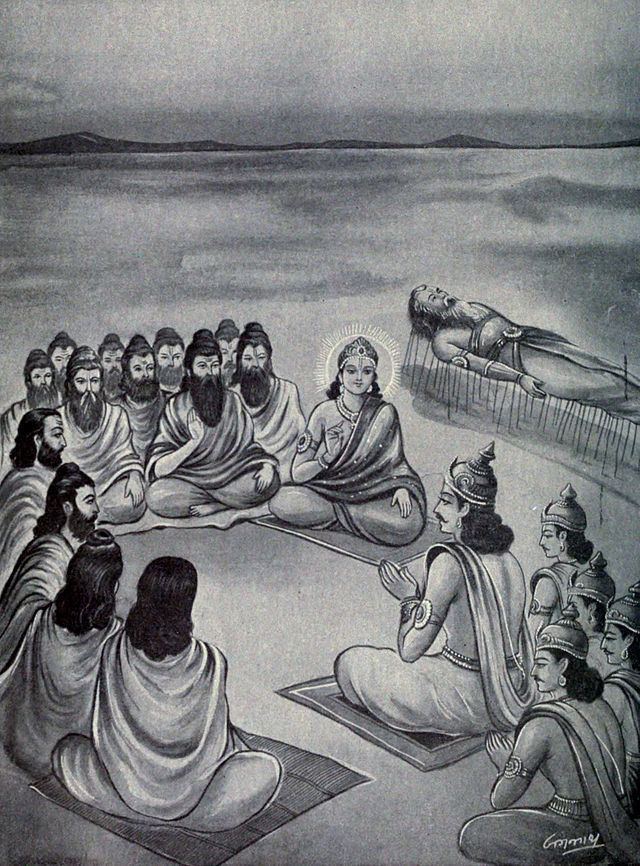 | ||
Anushasana Parva (Sanskrit: अनुशासन पर्व), or the "Book of Instructions," is the thirteenth of eighteen books of the Indian Epic Mahabharata. It has 2 sub-books and 168 chapters. Sometimes this parva is referred to as the "Book of Precepts".
Contents
Anushasana Parva continues the theme of Shanti Parva, a discussion of duties of a ruler, the rule of law, instructions on dharma for those close to the leader. The dialogue is between Yudhishthira, Bhishma and other sages. The book debates the duties, behaviors and habits of individuals, with chapters dedicated to men and to women. Various types of marriages are mentioned and their merits compared. The parva also recites many symbolic tales and legends such as the legend of Nachiketa, as well as the death and last rites of Bhishma, the eldest member of the Kuru family.
Structure and chapters
Anushasana Parva (book) has 2 sub-parvas (sub-books or little books) and 168 adhyayas (sections, chapters). The 2 sub-books are:
1. Dana dharma parva2. Bhishma svargarohana parvaThe Parva starts with a visit to Bhishma, who is dying. He is surrounded by sages and rishis including Vashishta, Maitreya, Sanat Kumara, Valmiki, Kapila, Vyasadeva and Narada. As with Shanti Parva, Yudhishthira asks for counsel and Bhishma replies. It includes duties of the king, officials of a kingdom, men and women. The book dedicates several chapters to cows, their importance to household's food security, agriculture and wealth.
Chapter 149 of Anushasana Parva recites Vishnu sahasranama - a list of 1,000 names (sahasranama) of Vishnu. Included in the list of 1000 names for Vishnu are Shiva, Sharva, Sthanu, Ishana and Rudra. This synonymous listing of Shiva and Vishnu as one, in Mahabharata, has led to the theory that all gods mentioned in Vedic literature are one.
English translations
Anushasana Parva was composed in Sanskrit. Several translations of the book in English are available. Two translations from 19th century, now in public domain, are those by Kisari Mohan Ganguli and Manmatha Nath Dutt. The translations vary with each translator's interpretations.
Debroy, in 2011, notes that updated critical edition of Anushasana Parva, after removing verses and chapters generally accepted so far as spurious and inserted into the original, has 2 sub-books, 154 adhyayas (chapters) and 6,493 shlokas (verses).
Critical reception
Scholars have questioned the chronology and content of many chapters in Anushasana Parva, whether they represent wisdom from ancient India, or were these chapters smuggled in to spread social and moral theories during India's medieval or during second millennium AD. Iyer, in 1923, compared different versions of Anushasana Parva manuscripts found in east, west and south India, in Sanskrit and in different Indian languages. The comparison showed that while some chapters and verses on Dharma and ethical theories are found in all manuscripts, there are major inconsistencies between many parts of the manuscripts. Not only is the order of chapters different, large numbers of verses were missing, entirely different or somewhat inconsistent between the manuscripts. The most inconsistent sections were those relating to women's rights and duties, discussion of social customs, castes, and those highlighting praise of specific gods. Iyer claims these chapters were smuggled into the Mahabharata, or the answers to question of Yudhishthira and other characters were entirely rewritten to suit local agenda or views. Alf Hiltebeitel similarly has questioned the authenticity of numerous verses of Anushasana and Shanti Parvas.
